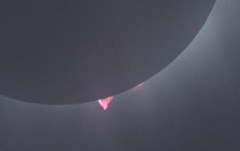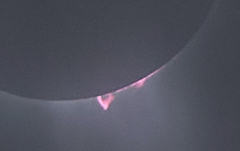|
Total Solar Eclipse
Luckenbach, TX
April 8, 2024
For the April 8, 2024, total solar eclipse, we participated in the Eclipse Megamovie 2024 project, a citizen participation science project to collect scientific data on the solar corona, which is only visible from Earth during a total solar eclipse. We wrote software to automate taking photos from five cameras for what we wanted to capture from the eclipse as well as the data needed for the EM2024 project. We did many dry runs inside to test the automation and also some outside on sunny days to practice setting up and aligning the equipment to track the sun. The photo below is from February 23.
We wanted to take more equipment than was reasonable to haul on a plane, so we drove it all to our chosen observation spot in Fredericksburg, TX. The weather was very nice, clear the whole way there, with lots of great scenery. Something that surprised us was the huge number of wind turbines in Texas. Multiple times we saw hundreds of them laid out on a grid fading into the distance.
Barbara, Cathy's Mom, opted to skip the 5,000-mile road trip and flew south to join us for the eclipse.
We rented a house with a huge yard on the outskirts of Fredericksburg, TX, and were able to practice our setup and photography a few days before the eclipse.
Eclipse Day!
We chose Fredericksburg, TX, because historical weather data gave that area of Texas the best odds of low cloud cover for anywhere in the US. Unfortunately, the weather did something unusual and covered most of the eclipse path in clouds, all the way up to Maine where it was clear in historically the most cloud-covered area of the path.
Weather. 🙄
We studied the weather predictions and decided there was nothing within reasonable driving distance that had a significantly better chance of clear skies, so we stayed put and hoped for the best.
The day started fairly clear, so we were able to set up the cameras with the various lenses/telescopes and get the tracking hardware aligned to track the sun. We got some nice photos of the beginning of the partial phase showing a couple of nice sunspots. Fingers crossed.
As totality approached, the cloud cover was getting thicker with fewer clear spots rolling by. The photo below shows the partially eclipsed sun poking through a thin spot in the clouds, still thick enough that getting a good exposure took twice the normal shutter time. Fortunately, our software running the cameras was taking a range of exposures for just this reason.
Even through the clouds, the skies darkened as totality approached, but glimpses of the sun were getting less frequent. For the 50 minutes leading up to totally, we didn't see the sun at all. The clouds were constantly moving through the sky, so all we could do was hope. Finally, totality arrived and with it near complete darkness. Where we were, totality lasted over four minutes, from 1:33:02 to 1:37:18 p.m. Although it was looking pretty grim, we kept scanning the sky hoping to see something. The clouds were so thick, we had only an approximate idea of where to look.
Much to our delight, the clouds thinned out just enough that we were able to see totality briefly!
Our cameras were all blasting along, taking photos continuously through a wide range of exposures, different for each camera. The trickiest bit is that the prevalence of clouds meant that we couldn't verify and adjust the alignment of the hardware to ensure the cameras were tracking the sun. For the cameras with the most telephoto lenses, the field of view was quite narrow, meaning even a small alignment error would cause the sun to move out of view during the hour and 20 minutes from the start of the partial eclipse to the start of totality. Fortunately, all of our cameras were aligned well enough to keep the sun positioned nicely in the frame.
Because the clouds were blocking so much of the light, taking photos required longer exposure times than originally planned. Tom made a small adjustment to his programs to compensate some but also still give good results if things miraculously cleared up. Knowing the weather report, Cathy developed an alternate shooting plan for the clouds and switched to it when the clouds thickened before totality. We both got some good photos.
We got just a few really nice photos that show this eclipse's signature prominences. Even though the photo below looks clear and sharp, it was shot through clouds thick enough to reduce the light by about 10 stops. Said another way, what we saw was only 1/1000 as bright as what it would have been in clear skies. The exposure used for the photo below was intended to capture the full wispy width of the corona, but instead captured just the brightest part of the eclipse: the inner corona and prominences.
As we saw in the 2017 eclipse, the motion of the moon across the sun changes how the prominences appear. The prominences at the bottom became more exposed as the moon traveled "up" relative to the sun.
We also set up a camera to take a photo of our observation field every 15 seconds and compile them into a time-lapse movie. It runs from when we started setting up the equipment that morning until we tore it all down. At 450x real time, the 4 minutes of totally would show for only half a second, so the movie below has been modified to make that brief bit (around the 33-second mark) last long enough to see it become so dark that the images are dominated by our laptop monitors.
For the return trip, we had a more flexible schedule so we could take in some sights and visit friends and family. As we made our way north through Texas, we met up with Dave, a friend from the puzzle community. We had dinner with him at Krua Thai, a strip-mall Thai joint with a sassy attitude and great food in Abilene, Texas. They had a white board with quite a list of rules and admonitions for bad behavior. Tom wanted to take a photo of it, but worried we'd get chased out with a broom if they guessed his desire to poke fun at them on the inevitable travelogue web page.
Sand Dunes
Great Sand Dunes National Park and Preserve in Colorado features sand dunes nested among the mountains at 8,000 feet. There you can hike through trees with a snow-fed stream, then wander over to the dunes, like those two climates should be next-door neighbors.
This high-resolution panorama is suitable for viewing on a VR headset for an immersive experience.
Gators
What else do you expect in the mountains of Colorado? How about a rescue center for alligators? Sure, that makes sense. Colorado Gators is built on a site with access to a hot spring, so they have a natural supply of hot water. And now a lot of alligators. They are even thoughtful enough to make charging available for electric vehicles, which is otherwise pretty scarce in the area.
Cathy was more interested in feeding a tortoise than cuddling an alligator.
Wild Animal Sanctuary
The Wild Animal Sanctuary near Denver, CO, is a sprawling refuge for animals rescued from around the world. People take on "pets" they can't handle when they become large carnivores. Zoos go out of business or find themselves in the middle of a war with no staff. Animals brought here live out their lives in a much better environment than a small, dark cage. Below are some of the animals we saw from the elevated walkway.
Liberty Puzzles
We discovered Liberty Puzzles a few years ago and have been hooked ever since! Their jigsaw puzzles are made from wood and contain "whimsy pieces," fun shapes related to the theme of the puzzle. While in the Denver area, we stopped by for a tour of the Liberty Puzzles factory in Boulder.
They offer piece replacement, for free if it was their error, or otherwise for a small fee. They collect photos of the culprits that are responsible for the damage or destruction; mostly dogs, but also cats, birds, and even the occasional Roomba. There is a collage of those photos on a wall in their facility, so of course we posed by that.
Some of the puzzles contain pieces that can be assembled into 3-D figures. They have a few samples on display in the office.
While in the Denver area, we got together with Cathy's brother, Bill, his wife, Becky, and their adorable dog, Pip.
Utah
We spent several days in Utah to visit Tom's Uncle Ed and some friends from Tom's college days. The annual awards ceremony for the math department at the University of Utah, Tom's alma mater, was conveniently scheduled that week. It's always inspiring to hear about the amazing things that bright, motivated young people are doing. Whenever we're in the Salt Lake City area, we find our way to Luna's Kitchen in Park City. They offer a variety of amazing treats, including gluten-free cinnamon rolls that Cathy adores.
|
©1996-2025 Tom and Cathy Saxton. You may not copy or reproduce any content from this site without our consent.



















